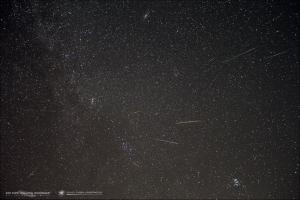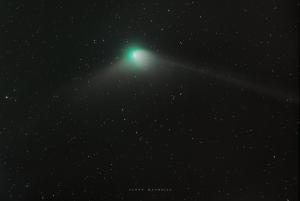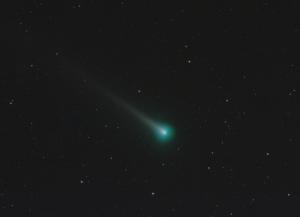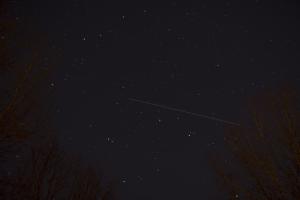Celebration of Space - November 17, 2023
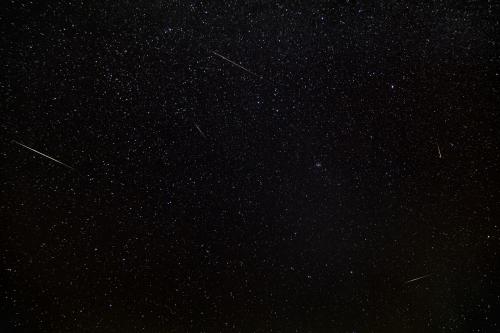
The radiant point of the annual Leonid meteor shower. Note that most of the meteors in this photo are not Leonid meteors. Credit: Frosty Drew Astronomy Team member, Scott MacNeill, captured this image at Frosty Drew Observatory.
Overnight tonight into tomorrow morning, Friday-Saturday, November 17-18, 2023, the annual Leonid Meteor Shower will peak, bringing with it an increase in regular meteor activity by about 15 meteors per hour. Even though it will be cloudy tonight, you are not missing much as the Leonid Meteor Shower is quite unspectacular, outside of the 33 year storm cycle, which is not happening this year.
The Leonids are a product of the comet 55p/Tempel-Tuttle, which is a periodic comet that has an orbital period of 33 years. As the comet comes into the inner Solar System, it starts to out-gas due to the intense solar wind that is present in the inner Solar System. This out-gassing will result in a debris field of dust and rice-grain sized pieces of ice and rock along the comet’s orbit. Each November Earth will orbit into this debris field and these particulates will become captured by Earth’s gravity and will enter the atmosphere at speeds of 43.5 miles per second. When they encounter the density of the lower atmosphere levels, they will burn up and leave a bright(ish) streak across the sky.
The 33 year period of intense meteor activity comes down to the extremely close proximity that the comet comes to Earth during its perihelion transit (closest approach to the Sun). At its closest point to Earth, the comet will be about 740,000 miles, which is around three times the average distance of the Moon from Earth. Because of this close pass, Earth will pass through very dense streams of debris from the comet, producing fabulous viewing conditions. The last time this happened was in November 2001, when thousands of meteors per hour were visible.
If you feel like you should try to observe the shower tonight, and you have a clear sky, set out to a location largely free of light pollution, and be there for midnight. Considering that the 27% waxing crescent Moon will set around 8:00 pm tonight, the sky should be remarkably dark for a view. Lay on your back with your feet oriented to the southeast, and look to the zenith (top of the sky). Maybe you will catch a Leonid or two. In past years, when observing the Leonid peak, we have observed more Taurid meteors than Leonid meteors. But hey, maybe you will score a great night. Let us know if you see any.
Over the past several weeks an old comet has been putting on a new show in the night sky, and it is really calling attention to its icy self with a few outbursts that have brought it to light. The comet is 12P/Pons-Brooks, which was discovered in the early 19th century. It has an orbital period of 71.3 years, which makes it a periodic comet. The comet will make another close approach to the Sun (perihelion) during April 2024, just before the fabulous total solar eclipse on April 8, 2024. It is expected to become bright enough to be seen with the naked eye, which means that it may be visible during the total eclipse period. How cool would that be?!
What has recently put Comet Pons-Brooks into the spotlight is that the comet keeps producing outbursts. An outburst occurs when a pocket of volatile material in the comet’s nucleus becomes exposed to the solar wind. This pocket will quickly sublimate (changing from a solid to a gas, skipping the liquid state of matter), and form an atmosphere around the comet, called a Coma. The first outburst that the comet experienced was this past July, which expanded the coma to a diameter of 373,000 miles. Then a second outburst occurred on October 5, 2023, which increased the brightness of the comet by over 40 times. Two more outbursts occurred in November, one was on the 1st, the second on the 14th. The comet is currently at magnitude 9, which makes it visible to backyard telescopes. If this outburst activity continues, we may have a stunning naked eye comet in 2024, in the same manner as Comet 17p/Holmes did during the early 2000’s.
For the zealots, or better stated – “intense enthusiasts” that may want to try for a view, the comet is currently in the constellation Hercules, and will cross into the constellation Lyra on November 24th. For the rest of us, perhaps waiting until the New Year will allow for an easier view. That is unless the comet keeps out-bursting, then perhaps everyone will see it. We’ll post updates as the comet’s perihelion passage evolves.
After a bit of a lull in space station evening passes over the US. The International Space Station (ISS), and China’s National Space Administration Tiangong Station have returned to the evening sky over the US. Evening passes are the best passes to observe because they happen during a time-frame that is easily accessible for all family members. During this time of the year, evening passes will happen quite early, making it even easier for the whole family to get out and experience. Here are several notable passes of the stations for the next seven days:
ISS:
Fri, Nov 17 at 6:25 pm, starting in the WSW, rising to 47º, and into orbital sunset
Sat, Nov 18 at 5:37 pm, starting in the SW, rising to 87º, heading towards the NE, and into orbital sunset ← Awesome pass!
Sun, Nov 19 at 4:50 pm, starting in the SW, rising to 53º, heading towards the ENE ← Awesome pass!
Mon, Nov 20 at 5:39 pm, starting in the W, rising to 35º, heading towards the NNE, and into orbital sunset
Tue, Nov 21 at 4:51 pm, starting in the WSW, rising to 54º, heading towards the NE ← Awesome pass!
Wed, Nov 22 at 5:41 pm, starting in the WNW, rising to 20º, heading towards the NNE, and into orbital sunset
Thu, Nov 23 at 4:52 pm, starting in the W, rising to 26º, heading towards the NE.
Tiangong:
Sun, Nov 19 at 5:42 pm, starting in the S, rising to 14º, and into orbital sunset
Mon, Nov 20 at 6:17 pm, starting in the SW, rising to 28º, and into orbital sunset
Tue, Nov 21 at 5:16 pm, starting in the SSW, rising to 22º, heading towards the ESE, and into orbital sunset
Wed, Nov 22 at 5:52pm, starting in the WSW, rising to 52º, heading towards the SE, and into orbital sunset ← Awesome pass!
Thu, Nov 23 at 4:51 pm, starting in the SW, rising to 34º, heading towards the E
Thu, Nov 23 at 6:27 pm , starting in the W, rising to 35º, and into orbital sunset
Put these times on your calendars and set your alarms. There are a few awesome passes listed above, which will make for stunning views. You will notice that many passes end in orbital sunset. This happens when the station orbits into Earth’s shadow. During this time the passengers of the stations will be experiencing sunset, which happens every 90 minutes on the stations. Note that these pass times are for Southern New England, but are generally usable for the entire Northeast region. For daily pass times of the ISS, Tiangong, and other bright satellites, visit the Frosty Drew Daily Satellite Pass Prediction Utility. Now get out there and be amazed!
- Author:
- Scott MacNeill
- Entry Date:
- Nov 17, 2023
- Published Under:
- Scott MacNeill's Columns

